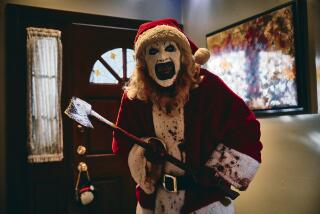‘Fear Street Part 3: 1666’ pulls off a magic trick: It’s the best of the trilogy
- Share via
Consider the sequel curse broken: “Fear Street Part 3: 1666” satisfyingly wraps up Netflix’s R.L. Stine movie trilogy with deepened themes, more fully realized characters and enjoyable twists that lend dimension to the arching story.
Whereas the first two “Fear Street” movies paid tribute to horror films from the eras in which they were set, “1666” is its own animal. Perhaps it contains echoes of “The Village” or “The Crucible,” but it doesn’t feel constrained by those parameters. Also, perhaps being forced to write outside of contemporary idioms reduced the third installment’s use of clichéd and clunky dialogue. There are fewer jump scares as well, series director and co-writer Leigh Janiak relying more on the creepiness of the setting and our involvement in the story than in parts 1 or 2. Because this was designed as a trilogy rather than a slasher film and its thrown-together sequels, the, um, stakes are considerably higher in Part 3.
“1666” picks up from the end of “Part 2: 1978,” when series lead Deena (Kiana Madeira) thought she was ending the Shadyside Witch’s curse but instead found herself somehow transported to the Witch’s/Sarah Fier’s time, seeing the world through her eyes and living in her body. At last, we learn the truth behind the Witch’s legend and the events leading to her death, but not in quickie-flashback treatment. Rather, the bulk of the film is set then, exploring the characters, their motivations and their world.
Don’t worry, there’s still evil magic and blood to come.
“1666” being set hundreds of years before the other two movies, we don’t get to see younger versions of the characters we’ve come to know. Rather, we see the actors from those previous films (especially “Part 1: 1994”) playing denizens at the time of the town’s founding, lending some instant context for characters and relationships.
Until the big set-piece climax, “1666” also has the lowest on-screen body count of the trilogy. Tension instead comes from the deadly event toward which we know Sarah Fier is inexorably being dragged, but with Deena trapped in her circumstance.
‘Fear Street: 1994’ is just the first part of a new horror trilogy arriving on Netflix in July. We’re breaking down the most pressing questions for the next two films to answer.
Part 3 also represents the trilogy’s clearest expressions of its feminist and class-struggle themes. Toxic masculinity, homophobia and mob rule all play their poisonous parts in “1666,” tying all three films together and providing them with greater dimension.
Madeira delivers her best performance in the series as she labors desperately to escape Sarah’s fate and save her love from the same. With very limited screen time, the “real” Sarah, Elizabeth Scopel, effectively conveys the extreme emotions of her predicament. Janiak posts her most assured directorial effort, and she and her co-writers turn in a script that both involves us in the 17th century setting and the gonzo fun of the slam-bang finish.
It’s unusual that a sequel outperforms the original work artistically, and rarer still that a third film is the best of a trilogy; “Fear Street Part 3: 1666” pulls off that magic trick. It should make fans glad they hung around.
'Fear Street Part 3: 1666'
Rated: R, for for strong violence and gore, language, some sexuality and brief drug use
Running time: 1 hour, 52 minutes
Playing: Available July 16 on Netflix
More to Read
Only good movies
Get the Indie Focus newsletter, Mark Olsen's weekly guide to the world of cinema.
You may occasionally receive promotional content from the Los Angeles Times.











